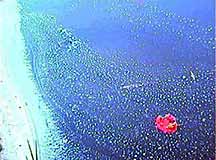 |
|||||||||||
|
Search the tourist-postcard blue sky for signs of a cloud.
You won't find one. It's dry out there. But exactly how dry is it? And why? by G. K. Sharman |
|||||||||||
| ABOUT THE DROUGHT Droughts happen. They're a natural part of Florida weather. Most years it rains a lot, some years it doesn't. Right now, it's really, really dry. Bone dry. Biblical plague dry. In fact, it hasn't been this dry here in 20 years. Scientists and water managers are using the words 'severe' and 'extreme' to describe current conditions.
Rainfall totals are way down. Lakes and streams are drying up.Springs are sluggish and some are brown with algae. Water managers worry about sinkholes and salt-water intrusions into wells. Lawn watering and car washing are down to two days a week for most residents and only one day a week in some populated parts of the state. A few hotels are even turning off the water late at the night and leaving bottled water in the rooms for guests. This particular drought is generally agreed to have gotten its start back in 1998 - October, to be exact, according to the U.S. Geological Servey. Before that, the previous big rain deficit occurred in the late 1970s - early '80s, and the one before that was in the '50s, said Leel Knowles Jr., a hydrologist with the USGS Orlando subdistrict office. The one in the '50s was several years in the making, he added, and hit the north-central part of the state most severely - and is perhaps most like current conditions. Drought, like economic theory, can be understood in terms of a simple principle: supply and demand. Supply - in this case, rain - is far below normal levels.'Normal' for Florida is between 50 and 60 inches of rain a year, depending on location. Nationally, the average is about 27 inches. Last year - which, for many areas, was among the driest on record - just under 29 inches fell in Tampa. Orlando was short more than 19 inches, Jacksonville 11 and Daytona Beach - which received 40 inches - was about 8 inches shy of 'normal.' But drought doesn't affect every place equally. One part of a water district (the state has a total of five) can have flooding while another is experiencing dry conditions. And there's a seasonal element: At least half of our liquid sunshine - and as much as 70 percent in some spots - falls in the summer, the season of thunderstorms and tropical weather systems. MORE |
|||||||||||
|
Water Restrictions The Water Cycle Silent Springs Solutions More Absolutely Florida Florida Weather Florida Dept. of Environmental Protection South Florida Water Management District |
|||||||||||
